Solvil Geneve KM Kriegsmarine Third Reich German military pocket watch WW2 RARE
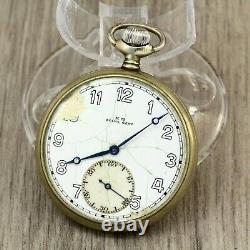
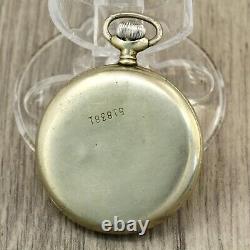
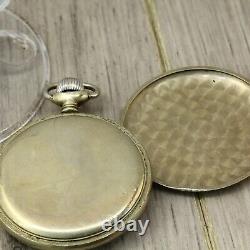
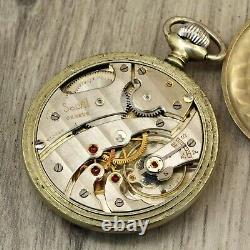
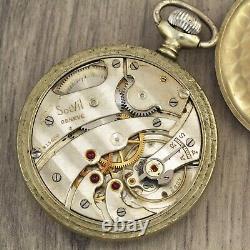
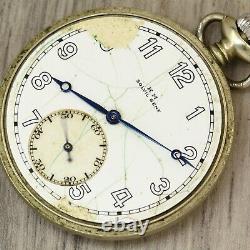
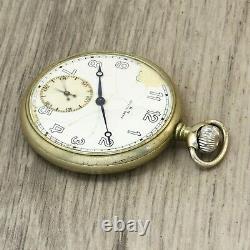
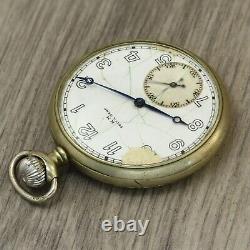

Solvil Geneve KM Kriegsmarine Third Reich German military mechanical pocket watch WW2 RARE. Caliber Solvil 42.9 (4292): incabloc, 15 jewels. It would be great find for any collector. Good condition for it's age! It has many traces and cracks on the enamel dial.
Traces of use on the case. Please see the photos for the assessment of watches. Runs well and keeps time accurately. Really watches look much better than in the photo. DEFECTS: many traces and cracks on the enamel dial. OVERALL CONDITION (10-point scale): 7-8. Inscriptions on the back cover. Open face calibre lever chronmeter experimental screw balance after Ditisheim/Guillaume with small bimetallic segments Elinvar Breguet-hairspring stem mechanism without setting-lever spring. Features stem wind and set sub second Data 19''', Dm= 42.3mm, Do= 42.9mm H= 5.3mm F= 0.6mm T= 3.4mm 15 jewels f = 18000 A/h power-reserve 34h Balance staff U1100 Stem W1599 Mainspring / battery Zf3511, 2.00 x 18.0 x 0.22 x 530mm Hands 1.62 x 1.00 / 0.25mm. 1.95 inch (49.5 mm). 2.44 inch (62.0 mm). 0.47 inch (12.0 mm). 1.71 inch (43.5 mm). 2.79 oz (79.0 g). The company was founded in 1883 by Gottlieb Hauser, a watchmaker in Winterthur who founded the Swiss Watchmakers Corporation ("Union Horlogère Suisse"). It is currently owned by Frédérique Constant. A number of watchmakers joined together as the. All representatives of Union Horlogère depended on the Association, which aimed to sell watches under the Alpina brand. Quickly, the new concept gained acceptance. Together with qualified manufactures, the Association started to develop its own calibres and to enlarge its distribution network.In 1912, the first Alpina Chronometer Glashütte was finalized and this model competed directly against the watch making of the likes of A. Lange & Sohne who even went so far as to take Alpina to court - unsuccessfully.
The company generally managed its business well until the 1970s, when quartz watch movements emerged and had a severe effect on the entire Swiss watch industry. Alpina was unable to counter the emergence of electronic watches. Other major brands got together to form groups (predecessor of the Swatch Group), but Alpina tried to fight it alone without really succeeding.
In 2002, Alpina Watch International SA was acquired by Frédérique Constant SA, returning the company to Switzerland, and Alpina watches were relaunched worldwide. Named "Régulateur 1883" in reference to the year Alpina was founded, Alpina introduced a new model in 2005. The "regulator" dial is distinguished by having an off-centred hour display at 10 o'clock - an exclusive Alpina feature. In 2008, Alpina Genève celebrated its 125th anniversary with the inauguration of the first movement to be made entirely in its own workshops.
Alpina first introduced its "4" line of sports watches in 1938, bringing together four themes: anti-magnetism, anti-shock, water resistance, and stainless-steel construction. The Alpina 4 was one of the very first Swiss sports watches to appear. In 2014, Alpina brought this concept back with the introduction of the new Alpiner 4 watches, available in both GMT and chronograph models. The new watches cover all four of the original requirements first set forth in 1938. Gottlieb Hauser founds the'Alpina Union Horlogère S. (UH) / Schweizerische Uhrmacher-Genossenschaft (SUG)' ('Corporation of Swiss Watchmakers').His vision was the'Alpinist Principle': uniting Swiss watchmaking industry forces to achieve the highest quality and technical innovation in manufacturing, at the most favourable conditions. Soon the Union was making its own calibers.
The Union moves its headquarters to Biel/Bienne where Jacob Straub, an important member, had his caliber manufactory J. The ébauches at that time were made by the Alpina Ebauches factory, owned by Duret & Colonnaz, in Geneva. The Alpina Union Horlogère participates to the 1900 Universal Exposition in Paris. The mark'Alpina' is registered by Jacob Straub to protect his 12 and 19 line calibers, unmarked until then. Its main caliber supplier, almost all high-end watches of the Union now carry the famous triangular'Alpina' mark on their movements.
Alpina, as a standalone name, was therefore first used as a protection and quality mark. Gottlieb Hauser and his son go on an adventurous mission to Russia to establish a foothold in the empire of the Tsars. They succeed: at the end of their 50 successive day's trip, their ledgers are filled with the names of surprisingly many new customers, including some famous ones. Wrote an account of this voyage: From Bienne to Astrakhan: "The Adventures of a Swiss Watch Representative in Russia Fifty Years Ago". On occasion of its 25th anniversary the Union registers the'Alpina' brand name for timepieces.
For prestige reason the Union members, the'Alpinists', agreed to use the brand'Alpina' only for watches that encased selected high-quality calibers, amongst them those with Breguet hairsprings and compensating balances. The Alpina Union Horlogère expands its watch manufacturing to Germany and founds the Präcisions-Uhrenfabrik Alpina Glashütte i/S in Glashütte. The Union`s factories were by now located in Geneva, Biel, Besançon (F) and Glashütte, the four world capitals of watchmaking. The Alpina Union Horlogère creates a perpetual calendar pocket watch complication.A significant technical challenge for that epoch. An Alpina 21-lines Glashütte Chronometer, equipped with an Alpina chronometer ebauche with Glashütte escapement, instead of the typical Swiss anchor escapement, was adopted as standard K. Equipment to cover its need for high precision time instruments. Alpina and American company Gruen enter into a joint venture with the purpose of getting access to their respective distribution networks and production facilities. The partnership gave birth to the Alpina'Tecno', encasing the famous 877 caliber.
The'Tecno' advertising brochure used the following words:'The new'Tecno' chronometer wristwatch boasts a trailblazing movement and shows the exact time in seconds: for physicians, engineers, technicians, transit officials, merchants and athletes. Alpina presents its first sports watch, the'Block Uhr'. It sported a sturdy all steel case and a patented a new type of crown (Brevet 1464). The innovation consisted of a very close-fitting connection between the crown and the winding stem to prevent dust from penetrating. Moreover, the crown could not be torn out or lost.
In 1938 the'Alpina 4' evolved from this first sport watch due to rapid technical progress. Alpina manufactures its first automatic movement. The 12½-ligne, 5.5-mm-tall, self-winding caliber 582, also known as the'P82', had a sub dial for the seconds at 6 o'clock and a power reserve of 40h. The school of watchmaking at the cantonal polytechnic in Biel chooses the 12-lines hand-wound Alpina caliber 592 to serve as the school's didactic caliber. This choice underscores the fact that this movement was especially precise, reliable and robust.
Alpina celebrates its 70th anniversary with the introduction of the'Alpina 70' sport watch, encasing the 592 and 598 calibers. The'Alpina 70' boasted the 4 Alpina sport features (anti-shock, anti-magnetic, water resistant, stainless-steel case), and a beautiful faceted golden'Alpiner' adorned its dial. The Alpina President is revealed. The President is the company's first Sports Automatic; using the 584'Hammerautomatik' 17 jewels self-winding Caliber. Alpina introduces the'Alpina 4' Chronograph.
The dial featured a telemeter and a units-meter, making it ideal for sports and industrial applications. Alpina realises an automatic movement for women, the caliber 362 (6½ lines); the smallest and strongest yet made. It worked with a rotor system, turning in both ways. In the same year Alpina also presents the'Comtesse' ladies line.Launch of the Alpina'Tropic-Proof'. This elegant sport watch with a'Qualité Geneve' case featured the 4 Alpina sport characteristics: 1/ anti-shock, 2/ anti-magnetic, 3/ water resistant, 4/ stainless steel case.
At the time the'Tropic Proof' was advertised as the'Gran Tourisme' of the sport watches. Launch of the Alpina Diver'10 Seastrong'. This professional diving watch was moved by a17 jewel Automatic self-winding caliber. The'10 Seastrong' featured 2 crowns, one of which was used to determine the decompression time through a 1-60 min. The'Seastrong' was water resistant to 200m and anti-magnetic.Alpina launches the'Dispomatic' Automatic Alarm encasing a modified 19 Jewels 2980 Lemania caliber with 21600 A/h. Despite the growing demand for quartz watches in this period, mechanical watches remained Alpina's vocation.
The Quartz Crisis strongly hit European and American mechanical watchmakers; Alpina suffered but remains an independent company. After the devastating effects of the Quartz Wave, Alpina missed the renaissance of mechanical watches, which began in the mid 1980s, perhaps because the new German owners were too far removed from the Swiss epicenter. For years the brand drifted without a clear direction. Fortunately, at the eleventh hour, when Alpina seemed inexorably on its way toward the watchmaking archives, Dutch entrepreneur Peter Stas came onto the scene and discovered the Swiss tradition sport watch brand and its significant horological history and legacy. Alpina was bought by Aletta and Peter Stas, the owners of Frédérique Constant.
Identifying with the'Alpinist principle', they set out to further the Swiss sport watch manufacturing vision of Gottlieb Hauser. Alpina presents its first collection of mechanical sports watches under the new ownership at the BaselWorld international watch fair. Introduction of the AL-650 regulator hand-wound movement based on the famous Unitas Ebauche, which was originally a caliber for pocket watches.Launch of the professional Alpina'Extreme Diver', water resistant to 1.000 m (3.280 ft). The'Extreme Diver' features a helium escape valve and, uncommon for watches going to these extreme depths, a transparent sapphire crystal case back. Alpina celebrates its 123rd anniversary by moving into its new watch manufactory in Plan-Les-Ouates, Geneva. At the same time it presents the Alpina'Avalanche Extreme', putting the Brand back on the map for watches that are made for extremely challenging sports environments.
Alpina presents its Automatic Regulator caliber AL-950. The caliber was entirely developed in-house by Alpina engineers; the parts machined on its CNC machines and assembled at the Alpina Manufactory. The AL-950 equips the Startimer Pilot Regulator Manufacture and the Avalanche Extreme Regulator. Alpina unveils its'Extreme Tourbillion' encasing the fully in-house developed and produced AL-980 Tourbillon manufacture caliber: the first Tourbillon movement ever produced by Alpina in its centenary history. The AL-980 incorporates two major new technologies: a Silicon escapement wheel and anchor give the caliber accuracy, even under extreme conditions, because no oil is needed to lubricate the escapement mechanism. Weight Balancing System, (patent pending), enables further improvement to the movement's precision. Alpina becomes the Official Timekeeper of the legendary 12 Hours of Sebring endurance race in Sebring, Florida.Alpina reveals its Extreme Sailing'Yacht Timer' containing the new AL-880 movement. Based on the SW500 chronograph, Alpina designed a specific mechanical module to time the 5- and 10-minute countdown to the departure line of the Regatta. In case of an interruption of the departure, the AL-880 movement gives the possibility to hold the countdown, and then release it again.
Alpina's AL-710 small date automatic manufacture caliber of is launched. An evolution of the first Manufacture Caliber of Alpina since its re-launch, the AL-710 adds a central second to this automatic movement. Alpina presents the Startimer Pilot'Worldtimer Manufacture', encasing the fully in-house developed and manufactured AL-718 automatic World Time caliber. The AL-718 is based on the AL-710 Manufacture Caliber and features a 24 time zone indication, night/day indicator and a small date at 6 o'clock.
It is extremely easy to use: the single crown operates all its functions. Alpina celebrates its 130th watchmaking anniversary with the "Alpina 130", a pilot chronograph inspired by a 1930s Alpina pilot chronograph, featuring both a telemeter and tachymeter on the dial. 76 years after having introduced the concept of the modern sports watch with the Alpina 4 in 1938, Alpina comes back with the concept of'4' in its Alpiner collection. The Alpiner'4' is a professional Alpine watch featuring the 4 sports properties 1 Antimagnetic, 2 Antishock, 3 Water-resistant, and 4 Stainless steel case. All Antique watches are mechanical.
Many repairs will not be cheap, as most likely they will require replacement of non-standard parts (unlike most late model watches). Antique watches should not be beaten or dropped - because repairs may be expensive. Antique watches are generally NOT waterproof. This is because waterproofing was not in general production until the middle of the 20th century for most watches.
Therefore you should protect your antique watch from exposure to moisture. If your watch becomes wet it should be dried off quickly. Carefully open all covers and use a hair drier to blow dry the movement, dial, covers, crown. This will reduce the amount of rust. If your watch becomes wet with any kind of salt water you should immediately immerse or spray your watch with fresh (no-salt) water to remove all the salt from the works before drying the watch completely.
Any salt left in the watch will combine with moisture in the air to rust metal components of the movement, case etc. Winding any mechanical watch tight may break the mainspring.
If you can avoid it do not wind the watch hard. When adjusting the hands of your watch, move them in a clockwise direction only. Counter-clockwise adjustments may damage the movement. It is desirable to adjust the hands of your watch at the same time every day. An automatic or self-winding watch should be worn for at least 8 hours a day. It is a mechanical watch in which the mainspring is wound automatically as a result of natural motion of the wearer's arm, to provide energy to run the watch, making manual winding unnecessary. If you must adjust counter-clockwise make it for small adjustments only i.Be careful and gentle when adjusting the movement speed (faster or slower). Don't make sharp movements, and don't touch other components in the movement especially the pendulum mechanism. Every 2-3 years it is necessary to service and oil vintage watches.
If the course of your watches is worsening and the accuracy of the reduction in the duration of the clock (autonomy) from one fully wound spring - it need a service. IF the watch is dirty - allow the watch to run down, don't wind it again until you have it serviced by a qualified watch repair expert.
Dust will absorb and remove important lubricants and cause the movement pieces to wear down. To clean the case, dial and crystal you should use a cloth that does NOT leave fibers as these may get caught up in the movement.
Check with your Watch repair expert to get an appropriate cloth. Keep your antiques watch away from magnets. Strong magnetic fields may affect the accuracy of your watch since some vintage watches were made with iron based components in the movement. Most Cases and Covers are fine components and will not handle abuse well.
The watch should not be shaken, beaten, or stressed. Antique watches generally experience an error of up to 5-7 minutes a day. Any accuracy of +- 5 minutes is very good. Mechanical watch is not recommended to use for engage in extreme sports, and expose them to excessive vibration loads.
Recoil force, which take on the clock, affect their reliability and precision. No matter how perfect was not anti-shock mechanism, there is always the chance of excessive load that details of the mechanism can not survive. It is not recommended to adjust, the date between 20.00 and 06.00, because at this time involved a mechanism for automatic adjustment date. Translation pointers calendars manually in this position arrows may damage the mechanism. Date changes should be made, relegating pre-clockwise to lower sector of the dial for example, to position 6 (18.00) hours.In most cases, these watches contain the "start/stop" button and "reset" button. It is strongly recommended not to press the "reset" if the chronograph is running. Before you use the "Reset" button need to stop the chronograph by button "start/stop". Using the "reset" when running chronograph can damage the mechanism of most models of watches.
In spite of delays all our previous lots have been successfully delivered! The item will be packed very carefully! United States of America, Canada, Australia, Albania, Algeria, Andorra, Antigua and Barbuda, Argentina, Armenia, Aruba, Austria, Azerbaijan, Bahamas, Bahrain, Bangladesh, Barbados, Belgium, Bermuda, Bolivia (Plurinational State of), Bosnia and Herzegovina, Brazil, Bulgaria, Cambodia, Chile, China, Colombia, Costa Rica, Croatia, Curaçao, Cyprus, Czech Republic, Denmark, Dominican Republic, Ecuador, Egypt, El Salvador, Estonia, Finland, France, Georgia, Germany, Gibraltar, Greece, Guadeloupe, Hong Kong, Hungary, Iceland, India, Indonesia, Ireland, Israel, Italy, Jamaica, Japan, Kazakhstan, Kuwait, Latvia, Liechtenstein, Lithuania, Luxembourg, Macedonia (the former Yugoslav Republic of), Malaysia, Malta, Mexico, Moldova (Republic of), Monaco, Mongolia, Montenegro, Morocco, Nepal, Netherlands, New Zealand, Norway, Oman, Panama, Paraguay, Peru, Philippines, Poland, Portugal, Qatar, Romania, Saudi Arabia, Senegal, Serbia, Singapore, Slovakia, Slovenia, South Africa, Korea (Republic of), Spain, Sri Lanka, Sweden, Switzerland, United Arab Emirates, United Kingdom of Great Britain and Northern Ireland, Uruguay, Viet Nam. It is impossible to address issues if we do not know about them! Thank you for your interest in our products!
Please let me know if you have any questions.
